-
MLK/FBI (Sam Pollard 2020)
SAM POLLARD: MLK/FBI (2020)
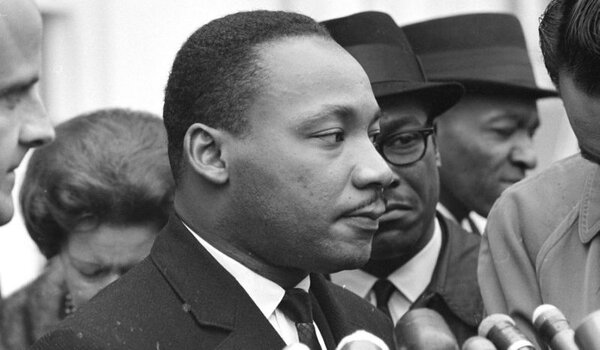
How the FBI hounded MLK and let him die
This is above all, a film that organizes things for us, things we may already know. It focuses on key dates. I'm not sure if there is a whole lot new here for one well acquainted with the US in the sixties. Tis may be the first film to uncover fully the extent of the FBI's surveillance and harassment of Martin Luther King, Jr. But what emerges that may be most fresh is a different sense of the mood of the country, what white Americans in general thought and felt. It's also a good-looking film. As is often the case now with modern digital editing techniques, everything looks snappy, and it's made stylish and unified by being almost entirely in brilliant black and white. It's a good choice not to have talking heads seen but archival footage, with the voiceover identified discretely by a name in the corner.
What we particularly need to know is that after the milestone March on Washington (August 28, 1963), with MKK's famous "I have a dream" speech, an example of his leadership, eloquence, and ability to rise to the greatest occasion, the number two man at the FBI, W.C. Sullivan, director for domestic intelligence operations, declared King to be "the most dangerous Negro in America." And they set upon him with all their ability to follow and snoop, with wiretaps and later "bugs" and officers in next rooms listening wherever King went. This film makes clear that this suspicion was not peculiar to the FBI, least of all the paranoia of FBI boss J. Edgar Hoover, but typical of the mood of the country at that time. Glimpses of many films show how Americans were indoctrinated in an admiration of the FBI. Women admired the agents and thought them sexy; little boys wanted to grow up to become them.
They found King relied heavily on a lawyer, Stanley Levinson, who was a former communist. He was brought up before the notorious HUAC, the House Un-American Activities Committee. President Kennedy met with MLK and warned him he must not associate with Levinson. King promised he would stop. This was a lie: he continued to see him.
I lived through this period, but this film has helped me see that I may very well have experienced it differently from a majority of white Americans. For some of us, the civil rights movement in the South was stirring; Reverend King was impressive; Black Power seemed right, the Panthers in Oakland a force for good. Many white Americans felt threatened. They saw the demonstrations and non-violent battles King led as did the UPS reporter Gay Pauley, who questioned King hostilely on air, as ending in blood, and hence dangerous and disruptive. King does not lose his cool, and has a good answer. But probably for many viewers, the questions were more important than the answers, and expressed their point of view.
For the FBI and perhaps much of white America, Black activism was as threatening and dangerous as communism and indistinguishable from it. The FBI feared "the rise of a Black messiah" in the success of MLK.
This film goes easy on J. Edgar Hoover. It describes his private life as "problematic," and quickly runs a montage of him with his male longtime companion. But Sullivan and Hoover together had it in for MLK.
When they ramped up their snooping on King, they soon discovered he had multiple extra-marital relations. From then on this became the major focus of their investigations of King. They gathered more and more data, and in private spoke with horror and disgust of King's sexual affairs, as filthy and disgusting. Coretta Scott King probably knew of them; in one clip she says she knew King better than anyone, as if to say so.
Next important date: November 22, 1963, the assassination of President Kennedy. President Johnson pushed through the Civil Rights Act as a memorial to Kennedy, and signed it June 2, 1964. In October 1964 MLK received the Nobel Peace Prize. This is shown. There is a bit of sexist condescension in the explanation that Coretta would indeed accompany him to Stockholm, even though she was the mother of four. (They didn't know the Nobel Committee would probably pay for the children to come too.) At the signing of the Civil Rights Act, King is standing close by; J. Edgar Hoover is hovering in front.
You can't say Hoover was merely a typical American in his growing hatred of King, which flamed out after the Nobel Prize, when he publicly declared "Dr. Martin Luther King is the most notorious liar in the country." At this point, the film shows, they started sparring, and eventually met up and supposedly spoke amicably.
Eventually there were "fifteen incidents" of MLK with women which the FBI made public, but the press, honoring King's reputation much enhanced by the Nobel Prize, didn't reveal these things. The FBI simply went on hounding King and eventually threatened and confronted him.
Finally the FBI sent King and his wife a tape compendium of recorded moments of him allegedly with other women in sexual situations along with a letter suggesting that he was utterly ruined and should kill himself. Clearly the FBI was off the rails in its persecution of King by this point. Former (2013-2017) FBI chief James Comey in voiceover says "this represents the darkest episode in the FBI's history." One may suspect King is not the only individual hounded this way, but we must take Comey's word on this.
From here on, King reportedly led to an "emotional crisis" for King, and he appeared increasingly agitated, though it's also said that he was too busy to obsess about the FBI's persecution of him. A decisive change came when, reportedly here inspired by a Ramparts article publishing photos of Vietnamese children disfigured or maimed by US napalm, King chose to speak out in opposition to the Vietnam war at last. When he did so decisively in his now well known speech in New York's Riverside Church, this meant he had cut himself off from the White House, as he acknowledged. The film reports that the press berated King for this stand: it shows multiple newspaper op-ed articles against him.
MOre details follow: notably, COINTELPRO, the FBI's massive program of surveillance and infiltration of political groups judged to be "subversive" (well covered in other documentaries). By this point, it's noted, Black activism was more a target than communism. This film names two Black undercover FBI agents who infiltrated Black activist groups: Ernest Withers, eighteen years an agent, and Jim Harrison.
MLK went on, instrumental in organizing the Poor People's Campaign, a program that was multi-racial, and further reaching than the previous civil rights movement. He was growing and changing (like Malcolm X), and we can only imagine what he might have achieved if he had lived beyond the age of thirty-nine.
King's leadership in the PPC was cut short by his assassination on April 4, 1968, which came the day after one of his best speeches, the film suggests - an alarm about crack-downs on the right to free speech in America that he had observed happening all over the country. For a while, the film ponders this event: clearly, the FBI followed King so closely, why didn't it see an impending assassination and stop it. Indeed.
MLK/FBI, 104 mins., debuted at Toronto Sept. 2020, and showed at New York, as part of which it was screened (virtually) on its NYFF release date, Sept. 25. Also slated for Chicago and putative US theatrical release Jan. 15, 2021.
Last edited by Chris Knipp; 08-28-2021 at 06:31 PM.
-
ISABELLA (Matías Piñeiro 2020)
MATIAS PIÑEIRO: ISABELLA (2020)
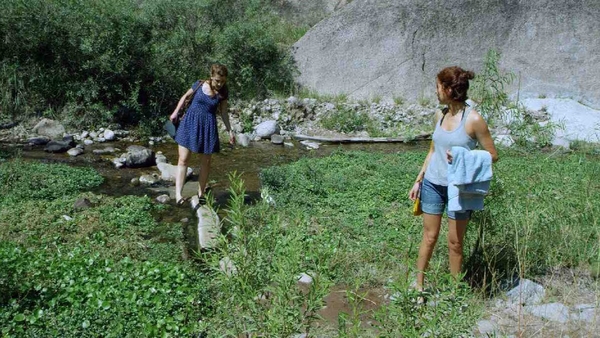
MARIA VILLAR AND AGUSTINA MUÑOZ IN ISABELLA
In which the young Argentinian still proves opaque
Argentine filmmaker Matías Piñeiro (previously reviewed here, Viola (ND/NF 2012) and The Princess of France, (NYFF 2014) is not a director whose work I've liked. But I'm back again, because how can one dislike something based on Shakespeare? Perhaps I just didn't get it and need to try harder. This year's NYFF blurb says Piñeiro again refers to Shakespeare, this time to "anchor a loose yet intellectually rigorous examination of life’s loves," etc. This makes the last five out of his filmography of ten films, if we count shorts, where he has done something like this; this is his sixth feature. For tis one, after a detour to New York (where he now lives) for his last, Hermia and Helena - not reviewed here - Piñeiro returns to his native Buenos Aires, including some beautiful country scenes shot in Argentina's Córdoba Province.
But what makes it tricky is Pineiro isn't just riffing off a Shakespeare text, but doing that indirectly while focusing on actors auditioning or rehearsing, who of course have personal issues of their own. And he very much makes use of a small personal company of players and friends he has been using repeatedly in these films, which may lead to inside references and jokes. Regulars include María Villar and Agustina Muñoz as, respectively, Mariel, a teacher with stage aspirations, and Luciana, a more established actress. The focus shifts back and forth between the lead-up to a crucial audition and a time years later.
And this time then there is the thing of the colors and the stones. The film begins with a beautiful sunset where the sky is violet, red, purple. At one point the stones are used to refer to a tone, when acting or speaking. There is also a ritual of twelve stones that are thrown.
As David Erlich notes on IndieWire, Piñeiro eschews establishing shots here that would show us where we are so it all seems to happen in a neutral present. "In many respects," writes Erlich, "this feels like an exercise that was [more?] important for Piñeiro to make than it is for us to see; playful but seldom fun, it’s the rare film so ensconced in its characters’ headspace that it doesn’t seem the least bit conscious of the fact that it’s being watched." Erlich thinks Piñeiro is ready to leave Shakespeare behind. Or at least he hopes so.
A writer for Criterion, Joshua Brunsting, calls Isabella "Easily the filmmaker’s most obtuse and elliptical work." If so, since that's been the problem all along, my choice to watch another of Piñeiro's similarly constructed movies seems like an ill fated one. Brunsting (I'd say) clarifies the film more than Erlich, in particular explaining the meaning of the constant moments showing color swatches and differently shaped stones, which partly refer to the main character Marion's later involvement in an art project similar to a color-and-light installation by James Turrell (the color compositions also very much resemble the work of Josef Albers). These represent different emotional tones. It's this film's "tonal and narrative shifts" that, Brunsting writes, make it a "densely layered work."
As we watch we clearly grasp, many times over given Piñeiro's habit of repetition, that Mariel (Maria Villar), who when initially seen is pregnant, as well as in need of funds, is in a kind of competition with Luciana (Agustina Munoz), a more successful actress who's involved with Mariel's estranged brother (Guillermo Solovey, relatively only glimpsed here), who is putting on the production of Measure for Measure in which Mariel would like to win a role. And as is gradually and repeatedly made clear, Luciana gets the role of Isabela (Isabel in Shakespeare's Measure for Measure, which is being put on in Spanish). Mariel renounces acting, and later, is involved in art projects.
The key scene in the play, shown only once in an audition with Mariel, comes when she stands before a judge who offers to release her brother if she will give herself to him. But Mariel's brother, who reads the judge's part in her audition, gives the role to Luciana.
As I have said before, a Piñeiro film works very well for professors or students to analyze, but not so well to watch. In a recent Brooklyn Rail interview with Piñeiro by Jessica Dunn Rovinelli, it's obvious he has only a vague idea what the colors and the stones mean, though he has external reasons for using them. He admits he knows very well where every segment in the time-shuffled film fits in the chronology, but he doesn't mention the viewer. For the editing, Piñeiro says it was "a little bit like doing a puzzle." He admits he tackled a jigsaw puzzle of a Jackson Pollock painting and "failed big time."
This time I watched Piñeiro's film and didn't try too hard to follow it. I just sat back and let the copious dialogue wash over me, enjoying the walks in the grasses of Córdoba Province and the play with colors and light, especially purple. The color, Piñeiro tells Brooklyn Rail, helps relax you. Otherwise, it's a Jackson Pollack jigsaw puzzle.
Isabella, 80 mins., debuted at Berlin Feb. 2020, showed at IndieLisboa in Aug., and was screened for this review as part of the Sept. 17-Oct. 11, 2020 virtual and drive-in New York Film Festival where it showed starting Sept. 24.
Last edited by Chris Knipp; 09-29-2020 at 08:38 AM.
-
HOPPER/WELLES (Orson Welles 2020) (Spotlights series)
ORSON WELLES: HOPPER/WELLES (2020) (Spotlights series)
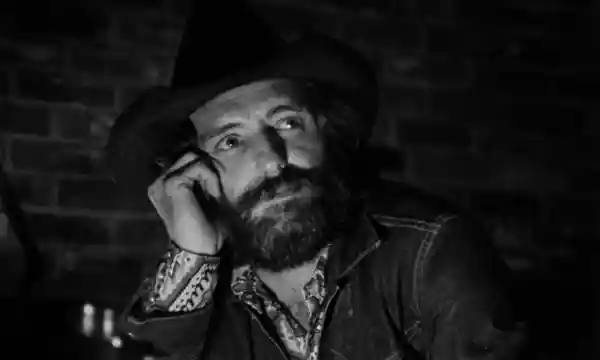
DENNIS HOPPER IN HOPPER/WELLES
The young dog and the old dog
This film, resurrected by producer Filip Jan Rymsza and editor Bob Murawski, who helped bring Welles’s unfinished The Other Side of the Wind to meticulously restored life two years ago is a collection of footage brought back to the light from film files. It's an odd, sometimes quite uneasy, experience. Take Dramamine before watching this film. It has the jitteriest, most messy camerawork you've ever seen, wobbly camera, sudden jerky zoom. Every few minutes the reel runs out and some underling walks into the shot and claps a clapper and says "3A - 3BX", or something like that, interrupting Hopper. It's insane. Half way through there appears a woman sitting near Hopper who starts laughing distractingly at his jokes. Then there's some other guy, another woman at the table. It is very disturbing. If you're interested in Dennis Hopper and Orson Welles, or perhaps in the mood in "Hollywood" in 1970, you want to take this in. But it isn't brilliant conversation, and some moments are embarrassing. They were both too drunk. But it has interesting moments, and sometimes when the camera is in focus and close up on Hopper and he's smiling, he looks great. At this moment when Hopper reportedly had flown to Los Angeles from Taos to see Welles and he was finishing his disastrous movie and Welles was finishing his never-finished Other Side of the Wind (so Hopper calls him "Jake" here, his role in that film), this happened. I dare say Welles looked at this footage and decided it wasn't usable. He was right. But it's Welles and Hopper talking, and here it is.
It's a house, dark, just lamps, with a roaring fire. Dennis Hopper is bearded and in a denim jacket and cowboy hat, drinking (he says) gin and tonics, and smoking Marlboros. In the background, never seen, shouting a bit, is Orson Welles. Hopper had made his famous movie, Easy Rider a year before, and was 34. Welles was 55 and had made his big movie, Citizen Cane, 29 years before. Or course Welles made other important films and is a great director, but also was looked on with some justification as a losing proposition, and living much of his time abroad. We must remember that Hopper had also played opposite James Dean in Rebel without a Cause andGiant in the fifties. Easy Rider seems dated now, and the film Hopper was finishing up, The Last Movie, was a disaster. It might be better to think of him as an actor and a personality who dabbled a bit in directing. I think of him as a very astute patron of contemporary art.
What's going on? Welles starts off as if he's interviewing Hopper, but you can't tell if he's interviewing or provoking. He is no interviewer, too definite in his views, to contrary, a bit of a blowhard. He admits his questions are childish (he says those get the best answers: do we agree?) but if he'd asked more specific ones it might have been more interesting. Hopper may be awed by Welles. He laughs a lot. It seems like nervous laughter, though it helps to make the "conversation" seem amicable. Sometimes it feels like he's channeling Bob Dylan a bit (whom Welles affects not to have heard of). But Hopper is so young, and Welles is such a back number, sometimes there's doubt whether either has anything to say, to the other, anyway. Both could be more interesting in other contexts - talking to the astute and witty Dick Cavett, for example. Both were on Dick Cavett's show, separately, and had good stories to tell, now and later. But of course those are artificial performances. This is more unpredictable. Perhaps its sheer raw messiness gives it interest.
About midway Welles calls Hopper "filmmaker, extraordinary leading actor, seminal personality for a whole generation." But as the evening wears on, he becomes more and more disagreeable and provocative. Hopper is convincing when he speaks of the radicalism around him in Taos, where he is living, and the danger for him of speaking out on politics when there are federal agents around who question him, yet Welles keeps pressing him to talk about his political beliefs. As Xian Brooks says in his Guardian review, we're watching "Welles frustrated by Hopper; Hopper tormented by Welles." Hopper is admirable for retaining his good humor. Welles is unjustifiably condescending. He just wants to provoke, not to listen. It's painful to watch. But go ahead and watch it.
In his Variety revoew, " Dennis Hopper and Orson Welles Square Off in 1970 in a Tantalizing Talk Plucked From the Vaults," Owen Gleiberman clarifies where both men where at this point and what Welles was trying to do in shooting this footage and in prodding Hopper. Sheri Linden in her Hollywood Reporter review presents a more positive picture of what's going on.
Hopper/Welles, 130 mins., debuted at Venice Sept. 8 and showed in the "Spotlight" section of the (virtual) New York Film Festival, where it was screened for this review; also scheduled for Busan and the American Film Festival in Poland. Metascore 68%.
Last edited by Chris Knipp; 09-28-2020 at 10:50 PM.
-
SWIMMING OUT TILL THE SEA TURNS BLUE 直游到海水变蓝 (Jia Zhangke 2020)
JIA ZHANGKE: SWIMMING OUT TILL THE SEA TURNS BLUE 直游到海水变蓝(2020)

CLIP OF VISITORS TO JIA'S NATIVE FENYANG GLIMPSED IN SWIMMING OUT TILL THE SEA TURNS BLUE
(Jia Zhangke Feb. 2020 Berlinale interview .)
Four writers with village pasts
No, this is not a film about immigrants braving the Mediterranean. In another documentary indirectly focused on modern Chinese culture, Jia Zhangke focuses this time on four writers, presenting them largely through their personal reminiscences, which go back to village origins and spans the early days of modern China, the Cultural Revolution included. One may be cast down by the typically blunt Chinese approach to things, but the craft of the film is fine, the score is elegant, and some of the accounts are very touching, going back often to difficult times of poverty and repression. But as in other Jia documents there is [I]a preponderance of talking heads, a little perfunctory like his Useless[/I] (NYFF 2007). His non-fiction just doesn't match his features. In his Variety review Guy Lodge says this completes "a loose nonfiction trilogy" focused on Chinese artists." His 2006 Dong was about a painter and Useless a fashion designer. This time this scope is more "sprawling," not just in looking at four artists instead of one, but in ranging around so much in history - and demographics; a recurrent concern is city vs. country, with most of the focus on country where they all started out. Alas, this film is not fun and not very enlightening. It's by a great filmmaker, but it's not a great film. If you think I'm being harsh, look at the Metacitic rating of Jia's last film, Ash Is Purest White - 85%, and of this film 0 57%. It's deliberately rambling. Though it has about 14 chapters, each new chapter is just another topic that comes up, like "eating," "mother" or "sister" when a main speaker mentions it.
He starts with Ma Feng, a famous writer from Jia's own native town of Fenyang in Shanxi province. Here, we begin with a gathering of elders, and some of them recall Ma Feng. Apparently Ma Feng's writing reflected the tumultuous changes of the Cultural Revolution, and there is a description of the difficulty of going to a college or even getting any kind of job during this period. His daughter tells about his working up from laborer to journalist.
The three living writers touched on are Jia Pingwa, Yu Hua and Liang Hong.
Jia Pingwa came from a family of counterrevolutionaries describes difficulty getting a job. His handwriting got him a gig painting slogans, and that led to better work and being sent to study literature at Northwest University in 1971. Later he won prizes for his many short stories featuring young men and women who were socialist heroes, but turned to native fiction celebrating his home province of Shaanxi. He has made a living as a writer since the eighties, but here he mainly recounts his scrappy beginnings.
Yu Hua recounts reading hand-me-down books saved from the Cultural Revolution that were so worn they had neither opening pages nor closing pages. He says it didn't matter who wrote the books, but he needed to know how they ended; so he began inventing endings for himself. Unmentioned here is that Yu Hua's Yu Hua’s novel To Live; became one of Zhang Yimou’s greatest films in 1994; it recounts the recurrent theme here, the trouble and repression of growing up in China from the forties to seventies. Yu Ha gave up trying to follow his bliss and became a dentist, for a while.
Liang Hong is a woman professor and writer who also focuses on poverty and exclusion growing up in a small rural town, Liang Village, near Zhengzhou, Henan, a subject of her fiction and nonfiction. (She has also written criticism and teaches literature and creative writing.) She almost breaks down describing her mother's illness gradually leaving to total paralysis, and a sense of exclusion in the town only increased when her father took in another woman after her mother's death, without marrying her. Liang's 14-year-old son, who's forgotten the local dialect since living in Beijing, talks for a bit as well, also reading from one of his mother's books. The line about the color of water comes from a return to Yu Hua, who remembers the water was always yellow near the shore when they swam as kids, though the textbooks said it was blue.
As has been commented by reviewers, this doc has good moments. The writer for Screen Anarchy, Dustin Chang, likes the storytelling. Guy Lodge of Variety sensibly prefers the scenes in between, such as a "gorgeous, gradually panoramic scene" of a village wheat harvest and of villagers harvesting wheat, another of a "flotilla of paper lanterns" on the Yellow River; and he commends and he commends Liang's 14-year-old son's "plainspoken interview," which indeed is a whiff of fresh air after all the oldsters and the weeping. But Lodge notices that the score, which even I, who often ignore musical backgrounds, notice is pretty heavy on the conventional classical stuff, is "patchier" than it ought to be due to reliance on Shshtakovich and Rachmaninoff, and worse, the "delicate footage of the Liang family’s trip to the cemetery," Lodge notes, "is ruinously scored to Puccini’s "Nessun Dorma." Opportunities for authentic musical cues are missed throughout.
Mostly what I see in Jia's nonfiction filmmaking is a certain laziness, a tendency to plunk people down and make them talk about their lives, instead of investigating and showing things, with, perhaps, relevant voiceovers from those otherwise uninteresting talking heads, whose bad teeth or poor complexions add nothing to our knowledge. Watching this film may appeal to some of the village people, or those studiously interested in them and Jia. This isn't worth ten minutes of one of his features and isn't worthy of him. The NYFF, which used to have too many documentaries, seems to have gone overboard this year.
Swimming Out Till the Sea Turns Blue 直游到海水变蓝, 111 mins. debuted at Berlin Feb., 2020, also showing at Docs Against Gravity (Poland) Sept., and the Main Slate of the New York Film Festival Oct. 2020, where it was screened virtually for this review.
Last edited by Chris Knipp; 10-01-2020 at 11:45 PM.
-
I CARRY YOU WITH ME/TE LLEVO COMINGO (Heidi Ewing 2020)
HEIDI EWING: I CARRY YOU WITH ME/TE LLEVO COMINGO (2020
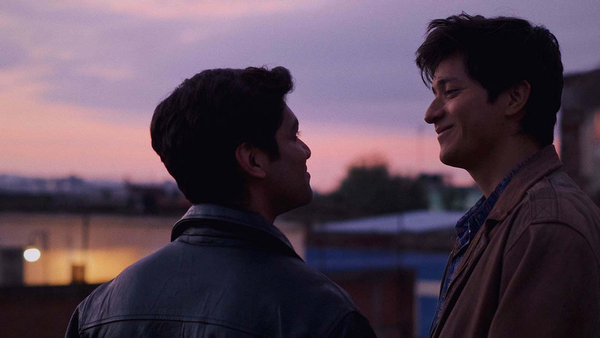
ARMANDO ESPITIA AND CHRISTIAN VASQUEZ IN I CARRY YOU WITH ME
Gay immigration movie makes its points well
Working with Rachel Grady, Heidi Ewing has made some fine documentary films. They've included Jesus Camp, The Boys of Baraka, the poetic Detropia, and a film about Norman Lear. This time, she has gone out on her own to produce a hybrid of fiction and non-fiction, acted elements and a final segment featuring the real people the first part is about. They are good friends of hers, a gay Mexican couple who came to this country illegally, one of them to become a cook.
The very things that make this an interesting choice for the New York Film Festival's Main Slate also call its inclusion into question. First, it's about pressing issues today: homophobia, illegal immigration. Second, it's bold in choosing to mix actors playing people with the actual people. But as is often the case with issues not much treated in film or still pressing, the treatment is very conventional, and insistent. Ewing and her cowriter Alan Page hammer their theme ceaselessly. Try to find a moment that is not pushing the bullet points of the story. You won't find many. Second, the introduction of the real couple is jarring and inexplicable. Some will be puzzled, others will think this destroys the integrity of the movie.
This may have read to programmers as innovative, but it's not some artistically compelling treatment of minority gay experience like Barry Jenkins's astonishing Moonlight (NYFF 2016). These are two ordinary guys. They got punished - in one case severely - for being 'different.' They grow up and meet at a DIY gay bar. Iván (the appealing Armando Espitia) is brought there by his bgf Sondra (Michelle Rodríguez), with whom he later will make the very difficult illegal border crossing. He meets Gerardo (Christian Vazquez) across a crowded room, and somehow they know. . . They fall in love, but the Mexican environment isn't remotely gay-friendly. Iván has an ex-wife and a kid. When she realizes he has a boyfriend, she doesn't want to let him see little Ricky anymore. All this is turbulent, intense, sometimes lyrical. Sometimes it's pumped up melodrama, except that its trajectory, though real enough and containing all the elements of a conventional hit, is standard issue.
Iván has gone to cooking school - one of several big steps in this chock-full epic that are skipped over here - but here in La Puebla, he can't get a decent job, and wants to go to America. Gerardo has a good job as a teacher and sees the crossover as nothing but danger and loneliness. After a painful crossing over for Iván aggravated by Sondra's physical difficulties with the trek (where perhaps Ewing's documentary experience helps), we get a quick run-through of some of Iván's numerous jobs on the way to something decent. After Iván has left, with the men vowing to reunite in a year, nothing happens for a while.
Gerardo is in touch, but Iván is moving so slowly that he resorts to pretending to Gerardo that he's become a cook. He's really washing cars, then, after many steps, doing dishes. His fortunes finally turn - in a realistic scene of an authentically toxic, macho restaurant kitchen - when a raging chef abusively and impulsively fires a line chef. It's Iván's chance say "I can help. . . I went to cooking school," and get the classic break.
Like that sequence, a lot of this is vivid, but also, when you think about it, generic. The element of manipulation is transparent at times. For instance when it's time for Gerardo to get motivated to come to the US on his own - Gerardo, who happens to have an effeminate, obviously gay best friend he's always out with, gets badly beaten up along with the friend. Then he's ready. Iván can't ever come back, and doesn't see his son Ricky other than on his smart phone for 20 years; this is where the actor Paco Luna is briefly fit in, on a smart phone, as the grown-up Ricky.
Ewing and her editor Enat Sidi are skillful at weaving in earlier moments illustrating the various elements that make these guys who they are and what they're motivated to do. The dp Juan Pablo Ramírez is certainly fully committed. The preponderance of sudden closeups, the shaky-cam that becomes markedly wobblier at emotional or dangerous moments, are visual elements that are obtrusive in the extreme and make lurid action even more so.
There is a cute little scene between the couple living together after Gerardo has gotten to New York, working on their English vocabulary. "How do you spell championes" (mushrooms) - No! I mean the English word!" It's a rare moment that fits the characters without serving a specific agenda.
Though we "meet" the "real" Iván and Gerardo for a while (not looking much like the actors who have played them), perhaps naturally, if they're still illegal, we don't really learn what their real names are or the details of what they do, though it's mentioned that in his several decades Iván has built up to where he's not only a chef, but owns businesses, plural. This was, to me, doubly jarring: the central roles suddenly assumed by non-actors, and the realization that we're not going to get full details of their story, after all.
I Carry You With Me is a touching tale pushing all the buttons and including a radical fourth-wall breakdown toward the end. It depicts important issues of homophobia and illegal immigration. But given the conventionality of the story, whether these elements justify the film's inclusion in the Main Slate of this year's (virtual + drive-in) New York Film Festival is another matter.
I Carry You With Me/Te llevo conmigo 111 mins., debuted at Sundance Jan. 2020, also scheduled for Athens, Zurich, The Hamptons, and Mill Valley, in addition to the virtual 2020 New York Film Festival, as part of which it was screened for this review. Metascore: 71%. Limited release by Sony Pictures Classics coming June 25, 2021.
Interview in Spanish with Armando Espitia.
Last edited by Chris Knipp; 06-15-2021 at 01:27 AM.
-
MANGROVE (Steve McQueen 2020)
STEVE MCQUEEN: MANGROVE (2020)
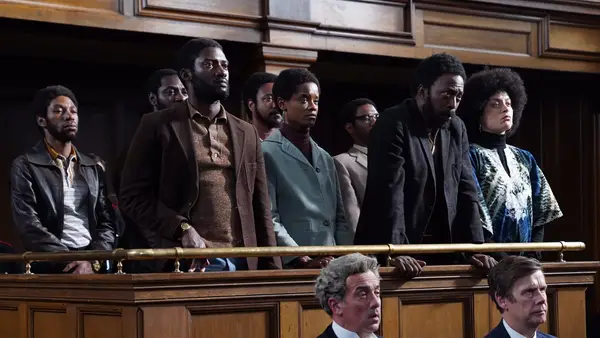
Mangrove tells this true story of The Mangrove Nine, who clashed with London police in 1970. The trial that followed was the first judicial acknowledgment of behavior motivated by racial hatred within the Metropolitan Police.
I began my NYFF 2020 coverage by declaring that my earlier prejudice against this filmmaker was wiped away by his Lovers Rock, which was chosen as the opening night film. I'd admired his Hunger, but felt worn down by his Shame, then beaten over the head and tortured by his 12 Years a Slave. With his mini-series "Small Axe" I see a new McQueen. He's still intense, and Lover's Rock is an awful lot of one kind of thing (dancing), but the two-hour Margrove, set in 1970 (opener of McQueen's 5-part "Small Axe" TV series, opening night film at the London Film Festival) is wonderfully economical too. This one is about police brutality and racism, so it couldn't be more relevant to 2020 America.
The trial that occupies the second half of the two-hour Mangrove historically led to a first "acknowledgement" of "behavior motivated by racial hatred" in London's police forces. It's a highly entertaining, technically brilliant trial sequence that can stand up to traditional examples of the familiar genre. But it's not exactly traditional. The "Mangrove Nine" on trial for "riot, affray and assault" at the Old Bailey, the court, as noted, reserved for the most severe offenses (where the film appears to have been shot) , are all of West Indian origin; the gallery is full of West Indians. Two of the defendants, Altheia Jones-Lecointe (Letitia Wright) and Darcus Howe (Malachi Kirby) act in their own defense, and they do so stunningly. The presiding Judge Edward Clarke (Alex Jennings), a lordly aristo who rules his court with dictatorial condescension, winds up pointing to the identified racially motivated behavior, which Peter Bradshaw calls in his admiring review of this film a "spectacular and unprecedented judicial admission".
The trial section contains plenty of speeches, and several stunning cross examinations, notably of the white racist Police Constable Frank Pulley by Darcus Howe. It's much condensed, since the trial, the Judge declares, took eleven weeks. But it still gives a feeling of thoroughness, as when the judge begins to read out the charges of each of the nine accused individually and get the jury's decision for each.
The first half, or nearly half, equally rich in another way, serves two purposes. It amply illustrates the racial bias in the police in their constant attacks on the restaurant. And a little moment with a rookie shows how "get a black man" is a game they're all taught to play, on "bad apple" interpretation possible. Above all this introduces us to the people, first of all to the passionately angry, brooding Frank Crichlow and his Mangrove restaurant, subject to violent raids from the late sixties, then to many other characters, including the skinny, long-necked Altheia with her Black Panther radicalism and her sing-song island accent; the high-pitched voiced Darcus with his big, light-skinned London-accented wife; the fat cook, Aunt Betty (Llewella Gideon), a regular in every restaurant interior scene; the older men Crichlow plays dice and cards with; and many others.
The raids are sudden and ugly, and when the police arrest Darcus he is returned to his own badly beaten, for no reason. Thus the West Indians of Notting Hill decide to stage a march and demonstration, up to the police station, leading to their violent confrontation and the arrests. Lest we think no white person is seen positively here, there is the young, outspoken liberal-left Scottish barrister Ian McDonald (Jack Lowden), who figures prominently, if not very effectively, in the trial. Not so much the odious snooty prosecution lawyer, or the older one for Frank Crichlow who tries to persuade him midway to plead guilty and abandon the others.
This is a high relevant story, but it represents a world that's clearly not 2020 America. Imagine: the black men are confident of their rights as citizens and residents. They they dare to be bold and confrontational toward the police. They aren't afraid of them. The police are armed only with batons. Big, big differences.
Mangrove, 126 mins., made for BBC, was to have debuted at Cannes, I think, but instead had its debut at the virtual New York Film Festival Sept. 25, 2020; shows also at London; and will be available with the other four parts of the "Small Axe" miniseries Nov. 20, 2020 in the US. An Amazon Studios release.
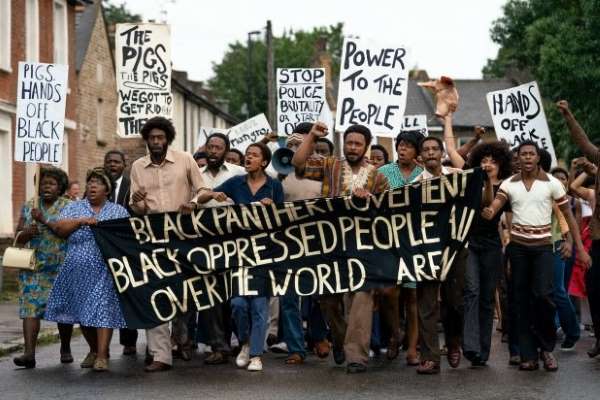
Last edited by Chris Knipp; 08-28-2021 at 06:37 PM.
-
ATARRABI & MIKELATS (Eugène Green 2020)
EUGÈNE GREEN: ATARRABI & MIKELATS 2020)
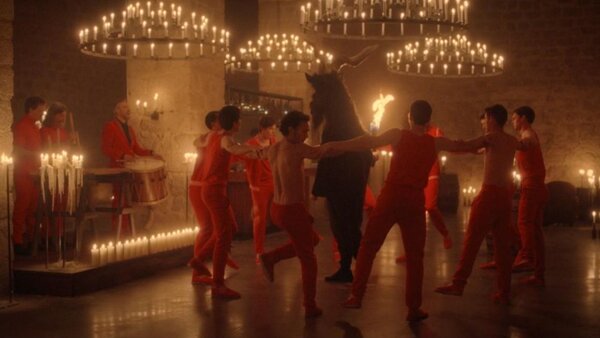
A myth of two opposite brothers
Green's new film recreates in modern dress an old Basque fable about good and the taint of evil. In the story the Goddess Mari is "visited" by a mortal and the result is two almost-twins, born within a few minutes of each other but not twins. She turns them over to an up-to-date Devil - he listens to rap on headphones while he does his "work" - for their education as small boys. When they grow up, Atarrabi (Saia Hiriart) wants to go out into the world. The Devil expects them both to remain and serve him. Only Mikelats (Lukas Hiriart) is happy to do that: he has a sly grin and enjoys playing around with the folks down below. The Devil allows Atarrabi to leave - but later, the escape turns out not to be complete.
Atarrabi is so saintly, he goes to join a monastery. But during training, the father superior finds, to his great disappointment, that the otherwise pleasing and admirable young man has no shadow, which means there is evil hovering about him. Hence he cannot join the order. He can only be a servant at the monastery but never a monk. Later, Atarrabi commits suicide at a mass because he feels his life has been wasted. A cardinal is called in who declares the father superior's wish to bury Atarrabi on the grounds cannot happen.
Unless - he suggests a test: put the body out on the mountain and if the birds of prey come and feed on it, it must be cast to the lowest place. If they don't, he can be buried in the holy grounds. In the final scene, a large bird comes, pecks at the corpse, and departs. A white dove comes and hovers at the body's breast - which is declared by to the Goddess Mari. End of story.
This is a more ethereal and strange - and celebratory and musical - film than Green's last NYFF film, The Son of Joseph. It's a lot less real and less interesting. But it's beautiful, with numerous exquisite scenes, many candlelit, music, dancing, and the beauty of the striking Basque-speaking Hiriart brothers.
All of this is in the Euskara Basque language, so presumably all the actors are Basque speakers. Apparently the brothers are. I'm ignorant of this subject, and this language, which has virtually no cognate words, putting it in a class with Georgian or Turkish or Hungarian, is a lot less relatable than major European languages or even Arabic or Japanese. Most of the Basques are Spanish speakers (as well as Basque) and a smaller number French-speaking I'm guessing this cast comes from the French-speakers. The language underwent standardization, Wikipedia tells us, but there are at least five dialects, and educational variations in all the different Basque regions. In my experience (with The Son of Joseph especially), Green's work has grown more accessible and enjoyable with repeated viewings. His work is hard going (like Bresson?) at first. Offhand, this one seems as though it will contain longeurs no matter how friendly you get with it. but we'll see.
As a somewhat troubling footnote, Eugène Green was expelled (by Basque police!) from the San Sebastien festival Sept. 24, 2020 for refusing to wear a mask or put it on properly after being asked to five times, and may have to pay a fine. (Variety). His accreditation was suspended and he lost his status as guest of the festival. The film was still shown, however, and the brothers who play the titular roles, Saia and Lucas Hiriart, remained for a Q&A.
Atarrabi & Mikelats, 123 mins., debuted at San Sebastien, Sept. 2020 followed by the virtual NYFF, where it was screened for this review. French theatrical release is scheduled for Nov. 18. Not many reviews; no interviews visible.
Last edited by Chris Knipp; 10-07-2020 at 01:33 AM.
 Posting Permissions
Posting Permissions
- You may not post new threads
- You may not post replies
- You may not post attachments
- You may not edit your posts
-
Forum Rules





 Reply With Quote
Reply With Quote







Bookmarks